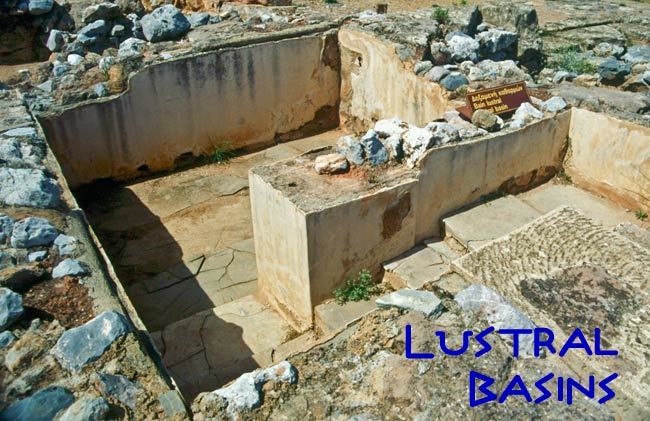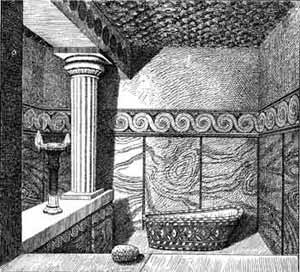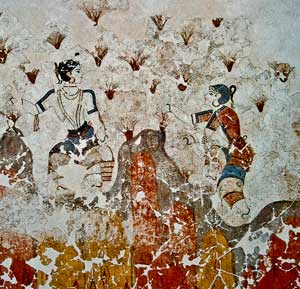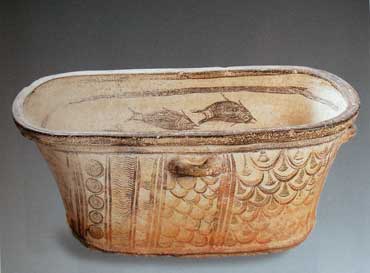
Lustral Basins were first identified by Arthur Evans at Knossos and consist of a sunken rectangular room reached by an L-shaped or dog-legged stairway. There is often a balustrade running alongside the  stairway, normally ending with a pilaster supporting a column. All of the examples at Knossos, like the one at Mallia (above) were lined with gypsum and so Evans thought they were used for bathing—a clay tub was even found in one of them. However, a few of them were found in areas of the palace, the Throne Room for example, where relaxing in the tub seems unlikely. In those cases Evans believed they were used for ritual purification through lustration—hence the name.
stairway, normally ending with a pilaster supporting a column. All of the examples at Knossos, like the one at Mallia (above) were lined with gypsum and so Evans thought they were used for bathing—a clay tub was even found in one of them. However, a few of them were found in areas of the palace, the Throne Room for example, where relaxing in the tub seems unlikely. In those cases Evans believed they were used for ritual purification through lustration—hence the name.
This interpretation has come under question in recent years, however. For one thing, the rooms are not very well designed for that particular purpose. Gypsum is not the ideal waterproofing agent (for one thing, it is somewhat water soluble) and, in any case, not all of them have paved floors. The fact that—in a palace noted for its superb plumbing— there are no drains in any of the rooms also  raises doubts. Of course, it can be argued that the bathing was done in clay tubs, which were then carried away by servants to be emptied but that assumes that the tub found in the bathroom of the so-called Queen’s Quarters at Knossos (above right) was used for that purpose. In fact, they are a type of coffin known as a larnax and its resemblance to a classic Victorian bathtub may be purely coincidental.
raises doubts. Of course, it can be argued that the bathing was done in clay tubs, which were then carried away by servants to be emptied but that assumes that the tub found in the bathroom of the so-called Queen’s Quarters at Knossos (above right) was used for that purpose. In fact, they are a type of coffin known as a larnax and its resemblance to a classic Victorian bathtub may be purely coincidental.
Many lustral basins were found to contain cult objects such as offering tables or sacred vessels and the walls are often decorated with religious themes, such as the those (shown left) associated with the gathering of the crocus harvest from House Xesté 3 at Akrotiri on Thera. This would seem to indicate a religious function, to be sure, but one more associated with the renewal of the nature. In this instance perhaps, having to do with a chthonic or underworld deity. Many scholars now prefer the term Adyton, a Greek term meaning “off limits” and referring to the most holy part of a Classical temple.

